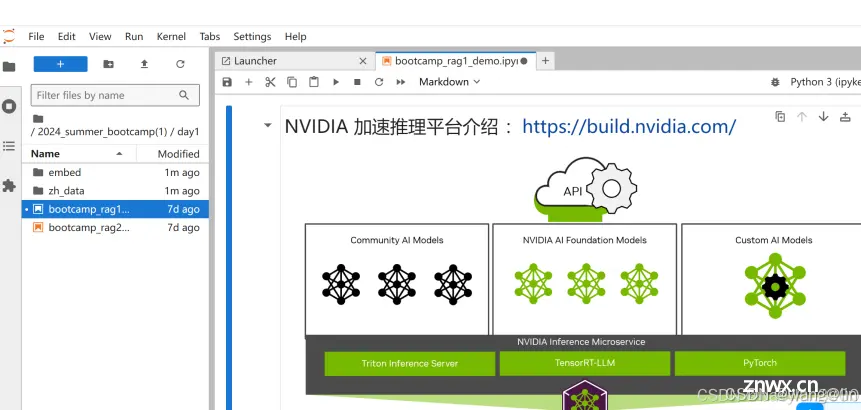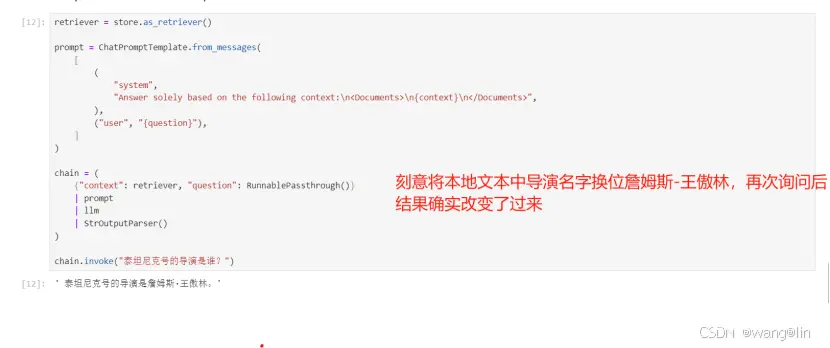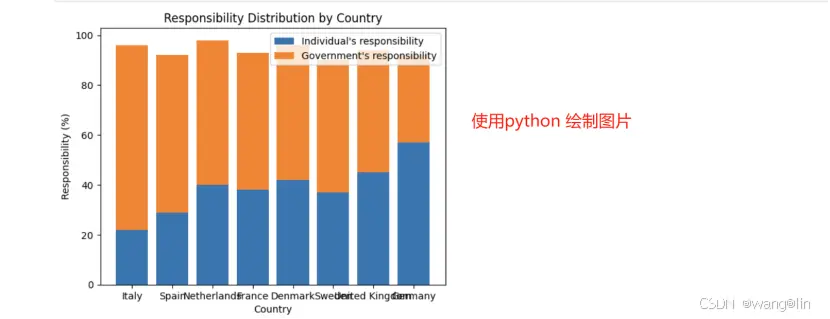【NVIDIA AI-AGENT夏季训练营-进阶版】
wang@lin 2024-08-26 11:31:02 阅读 64
NVIDIA AI-AGENT夏季训练营
项目名称:AI-AGENT夏季训练营 — RAG智能对话机器人
报告日期:2024年8月18日
项目负责人:[wangaolin]
项目概述(必写):
进阶版项目实操部分整体情况:首先介绍了多模态模型基于 NIM 的调用方式,然后讲解了基于 NIM 接口实现 Phi-3-Vision 的推理实践,最后说明了基于 Gradio 框架建立前端互动界面方法。
应用场景与亮点: 基于 NIM 建构多模态 AI-Agent 项目 小而精,适合小白入门。简明展示了多模态ai-agent构建的过程。适合各个场景,如图像文字交互的场景,生成ppt图片。主要亮点是小而精,入门简单。
技术方案与实施步骤
项目选择
选择microsoft/phi-3-vision-128k-instruct模型,主要是由于改模型小而精,运行速度快,适合工程化应用。
数据的构建(必写):
1)使用Image读入图片
2)将编码后的图像按照格式给到Microsoft Phi 3 vision , 利用其强大能力解析图片中的数据–调用Llama3 70b的模型,通过中文输入提示词,来进行工作
3)将处理好的提示词输入给char_reading, 也就是microsoft/phi-3-vision大模型来进行数据分析, 得到我们需要的表格或者说table变量
4)将Phi3 vision处理好的table和提示词输入给另一个大模型llama3.1, 修改数据并生成代码
5)生成的代码通过上面的执行函数来执行python代码, 并得到结果
功能整合(进阶版RAG必填):
首先定义了提示词模板, chart_reading_prompt, 我们输入的图片会边恒base64格式的string传输给它将处理好的提示词输入给char_reading, 也就是microsoft/phi-3-vision大模型来进行数据分析, 得到我们需要的表格或者说table变量将Phi3 vision处理好的table和提示词输入给另一个大模型llama3.1, 修改数据并生成代码将生成的代码通过上面的执行函数来执行python代码, 并得到结果将多模态智能体封装进Gradio
实施步骤:
环境搭建(必写): 描述开发环境的搭建过程,包括必要的软件、库的安装与配置。
1)创建Python环境
首先需要安装Miniconda:
#这里如果你原来装过anaconda就不用再装Miniconda了。
在打开的终端中按照下面的步骤执行,配置环境:
创建python 3.8虚拟环境
conda create --name ai_endpoint python=3.8
#这里是3.8及以上版本就行
进入虚拟环境
conda activate ai_endpoint
安装nvidia_ai_endpoint工具
#这是langchai和NIM结合的工具库
pip install langchain-nvidia-ai-endpoints
安装Jupyter Lab
pip install jupyterlab
安装langchain_core
pip install langchain_core
安装langchain
pip install langchain
安装matplotlib
#涉及数据可视化和图表绘制
pip install matplotlib
安装Numpy
pip install numpy
#安装faiss, 这里如果没有GPU可以安装CPU版本
pip install faiss-cpu==1.7.2
安装OPENAI库
pip install openai
#另外这里还缺两个安装包
一个是gradio一个是langchain-community。
pip install gradio -i http://mirrors.aliyun.com/pypi/simple --trusted-host mirrors.aliyun.com
pip install langchain-community -i http://mirrors.aliyun.com/pypi/simple --trusted-host mirrors.aliyun.com
2)利用Jupyter Lab打开课件执行

代码实现(必写):
1.rag
Step 1 - 使用NVIDIA_API_KEY¶
import getpass
import os
if os.environ.get(“NVIDIA_API_KEY”, “”).startswith(“nvapi-”):
print(“Valid NVIDIA_API_KEY already in environment. Delete to reset”)
else:
nvapi_key = getpass.getpass(“NVAPI Key (starts with nvapi-): “)
assert nvapi_key.startswith(“nvapi-”), f”{nvapi_key[:5]}… is not a valid key”
os.environ[“NVIDIA_API_KEY”] = nvapi_key
Step 2 - 初始化SLM
llm = ChatNVIDIA(model=“ai-phi-3-small-128k-instruct”, nvidia_api_key=nvapi_key, max_tokens=512)
result = llm.invoke(“泰坦尼克号的导演是谁?”)
print(result.content)
Step 3 - 初始化ai-embed-qa-4向量模型
from langchain_nvidia_ai_endpoints import NVIDIAEmbeddings
embedder = NVIDIAEmbeddings(model=“ai-embed-qa-4”)
Step 4 - 获取文本数据集
import os
from tqdm import tqdm
from pathlib import Path
Here we read in the text data and prepare them into vectorstore
ps = os.listdir(“./zh_data/”)
data = []
sources = []
for p in ps:
if p.endswith(‘.txt’):
path2file=“./zh_data/”+p
with open(path2file,encoding=“utf-8”) as f:
lines=f.readlines()
for line in lines:
if len(line)>=1:
data.append(line)
sources.append(path2file)
Step 5 - 进行一些基本的清理并删除空行
documents=[d for d in data if d != ‘\n’]
len(data), len(documents), data[0]
Step 6a - 将文档处理到 faiss vectorstore 并将其保存到磁盘
Here we create a vector store from the documents and save it to disk.
from operator import itemgetter
from langchain.vectorstores import FAISS
from langchain_core.output_parsers import StrOutputParser
from langchain_core.prompts import ChatPromptTemplate
from langchain_core.runnables import RunnablePassthrough
from langchain.text_splitter import CharacterTextSplitter
from langchain_nvidia_ai_endpoints import ChatNVIDIA
import faiss
只需要执行一次,后面可以重读已经保存的向量存储
text_splitter = CharacterTextSplitter(chunk_size=400, separator=" ")
docs = []
metadatas = []
for i, d in enumerate(documents):
splits = text_splitter.split_text(d)
#print(len(splits))
docs.extend(splits)
metadatas.extend([{“source”: sources[i]}] * len(splits))
store = FAISS.from_texts(docs, embedder , metadatas=metadatas)
store.save_local(‘./zh_data/nv_embedding’)
Step 6b - 重读之前处理并保存的 Faiss Vectore 存储
Load the vectorestore back.
store = FAISS.load_local(“./zh_data/nv_embedding”, embedder,allow_dangerous_deserialization=True)
Step 7- 提出问题并基于phi-3-small-128k-instruct模型进行RAG检索
retriever = store.as_retriever()
prompt = ChatPromptTemplate.from_messages(
[
(
“system”,
“Answer solely based on the following context:\n\n{context}\n”,
),
(“user”, “{question}”),
]
)
chain = (
{“context”: retriever, “question”: RunnablePassthrough()}
| prompt
| llm
| StrOutputParser()
)
chain.invoke(“泰坦尼克号的导演是谁?”)
2.ai-agent
第一步, 导入工具包
from langchain_nvidia_ai_endpoints import ChatNVIDIA
from langchain_core.output_parsers import StrOutputParser
from langchain_core.prompts import ChatPromptTemplate
from langchain.schema.runnable import RunnableLambda
from langchain.schema.runnable.passthrough import RunnableAssign
from langchain_core.runnables import RunnableBranch
from langchain_core.runnables import RunnablePassthrough
from langchain.chains import ConversationChain
from langchain.memory import ConversationBufferMemory
import os
import base64
import matplotlib.pyplot as plt
import numpy as np
第二步, 利用Microsoft Phi 3 vision 来解析图片数据
def image2b64(image_file):
with open(image_file, “rb”) as f:
image_b64 = base64.b64encode(f.read()).decode()
return image_b64
image_b64 = image2b64(“economic-assistance-chart.png”)
image_b64 = image2b64(“eco-good-bad-chart.png”)
from PIL import Image
display(Image.open(“economic-assistance-chart.png”))
instruct_chat = ChatNVIDIA(model=“meta/llama3-70b-instruct”)
result = instruct_chat.invoke(‘How to implement Fibonacci in python using dynamic programming’)
result = instruct_chat.invoke(‘怎么用 Python 实现快速排序’)
print(result.content)
第三步, 使用 LangChain 构建多模态智能体
import re
将 langchain 运行状态下的表保存到全局变量中
def save_table_to_global(x):
global table
if ‘TABLE’ in x.content:
table = x.content.split(‘TABLE’, 1)[1].split(‘END_TABLE’)[0]
return x
helper function 用于Debug
def print_and_return(x):
print(x)
return x
对打模型生成的代码进行处理, 将注释或解释性文字去除掉, 留下pyhon代码
def extract_python_code(text):
pattern = r’python\s*(.*?)\s*’
matches = re.findall(pattern, text, re.DOTALL)
return [match.strip() for match in matches]
执行由大模型生成的代码
def execute_and_return(x):
code = extract_python_code(x.content)[0]
try:
result = exec(str(code))
#print("exec result: "+result)
except ExceptionType:
print(“The code is not executable, don’t give up, try again!”)
return x
将图片编码成base64格式, 以方便输入给大模型
def image2b64(image_file):
with open(image_file, “rb”) as f:
image_b64 = base64.b64encode(f.read()).decode()
def chart_agent(image_b64, user_input, table):
# Chart reading Runnable
chart_reading = ChatNVIDIA(model=“microsoft/phi-3-vision-128k-instruct”)
chart_reading_prompt = ChatPromptTemplate.from_template(
‘Generate underlying data table of the figure below, :
’
)
chart_chain = chart_reading_prompt | chart_reading
<code># Instruct LLM Runnable
# instruct_chat = ChatNVIDIA(model="nv-mistralai/mistral-nemo-12b-instruct")code>
# instruct_chat = ChatNVIDIA(model="meta/llama-3.1-8b-instruct")code>
#instruct_chat = ChatNVIDIA(model="ai-llama3-70b")code>
instruct_chat = ChatNVIDIA(model="meta/llama-3.1-405b-instruct")code>
instruct_prompt = ChatPromptTemplate.from_template(
"Do NOT repeat my requirements already stated. Based on this table {table}, {input}" \
"If has table string, start with 'TABLE', end with 'END_TABLE'." \
"If has code, start with '```python' and end with '```'." \
"Do NOT include table inside code, and vice versa."
)
instruct_chain = instruct_prompt | instruct_chat
# 根据“表格”决定是否读取图表
chart_reading_branch = RunnableBranch(
(lambda x: x.get('table') is None, RunnableAssign({'table': chart_chain })),
(lambda x: x.get('table') is not None, lambda x: x),
lambda x: x
)
# 根据需求更新table
update_table = RunnableBranch(
(lambda x: 'TABLE' in x.content, save_table_to_global),
lambda x: x
)
# 执行绘制图表的代码
execute_code = RunnableBranch(
(lambda x: '```python' in x.content, execute_and_return),
lambda x: x
)
chain = (
chart_reading_branch
#| RunnableLambda(print_and_return)
| instruct_chain
#| RunnableLambda(print_and_return)
| update_table
| execute_code
)
return chain.invoke({“image_b64”: image_b64, “input”: user_input, “table”: table}).content
使用全局变量 table 来存储数据
table = None
将要处理的图像转换成base64格式
image_b64 = image2b64(“economic-assistance-chart.png”)
#展示读取的图片
from PIL import Image
display(Image.open(“economic-assistance-chart.png”))
user_input = “show this table in string”
chart_agent(image_b64, user_input, table)
print(table) # let’s see what ‘table’ looks like now
user_input = “replace table string’s ‘UK’ with ‘United Kingdom’”
chart_agent(image_b64, user_input, table)
print(table) # let’s see what ‘table’ looks like now
user_input = “draw this table as stacked bar chart in python”
result = chart_agent(image_b64, user_input, table)
print("result: "+result) # let’s see what ‘table’ looks like now
第四步, 将多模态智能体封装进Gradio
global img_path
img_path = ‘C:\Users\wal\Desktop\NVIDIA rag\’+‘image.png’
print(img_path)
def execute_and_return_gr(x):
code = extract_python_code(x.content)[0]
try:
result = exec(str(code))
#print("exec result: "+result)
except ExceptionType:
print(“The code is not executable, don’t give up, try again!”)
return img_path
def chart_agent_gr(image_b64, user_input, table):
image_b64 = image2b64(image_b64)
# Chart reading Runnable
chart_reading = ChatNVIDIA(model="microsoft/phi-3-vision-128k-instruct")code>
chart_reading_prompt = ChatPromptTemplate.from_template(
'Generate underlying data table of the figure below, : <img src="data:image/png;base64,{image_b64}" />'code>
)
chart_chain = chart_reading_prompt | chart_reading
# Instruct LLM Runnable
# instruct_chat = ChatNVIDIA(model="nv-mistralai/mistral-nemo-12b-instruct")code>
# instruct_chat = ChatNVIDIA(model="meta/llama-3.1-8b-instruct")code>
#instruct_chat = ChatNVIDIA(model="ai-llama3-70b")code>
instruct_chat = ChatNVIDIA(model="meta/llama-3.1-405b-instruct")code>
instruct_prompt = ChatPromptTemplate.from_template(
"Do NOT repeat my requirements already stated. Based on this table {table}, {input}" \
"If has table string, start with 'TABLE', end with 'END_TABLE'." \
"If has code, start with '```python' and end with '```'." \
"Do NOT include table inside code, and vice versa."
)
instruct_chain = instruct_prompt | instruct_chat
# 根据“表格”决定是否读取图表
chart_reading_branch = RunnableBranch(
(lambda x: x.get('table') is None, RunnableAssign({'table': chart_chain })),
(lambda x: x.get('table') is not None, lambda x: x),
lambda x: x
)
# 根据需求更新table
update_table = RunnableBranch(
(lambda x: 'TABLE' in x.content, save_table_to_global),
lambda x: x
)
execute_code = RunnableBranch(
(lambda x: '```python' in x.content, execute_and_return_gr),
lambda x: x
)
# 执行绘制图表的代码
chain = (
chart_reading_branch
| RunnableLambda(print_and_return)
| instruct_chain
| RunnableLambda(print_and_return)
| update_table
| execute_code
)
return chain.invoke({"image_b64": image_b64, "input": user_input, "table": table})
user_input = "replace table string’s ‘UK’ with ‘United Kingdom’, draw this table as stacked bar chart in python, and save the image in path: "+img_path
print(user_input)
import gradio as gr
multi_modal_chart_agent = gr.Interface(fn=chart_agent_gr,
inputs=[gr.Image(label=“Upload image”, type=“filepath”), ‘text’],
outputs=[‘image’],
title=“Multi Modal chat agent”,
description=“Multi Modal chat agent”,
allow_flagging=“never”)
multi_modal_chart_agent.launch(debug=True, share=False, show_api=False, server_port=5000, server_name=“0.0.0.0”)
multi_modal_chart_agent.launch(debug=True, share=False, show_api=False, server_port=8888, server_name=“0.0.0.0”)
项目成果与展示:
应用场景展示: 描述对话机器人的具体应用场景,如客户服务、教育辅导等。
功能演示: 列出并展示实现的主要功能,附上UI页面截图,直观展示项目成果。
1)本地rag问答



2)图片文字多模态问答





问题与解决方案:
问题分析:
1)gradio 未安装
2)路径不存在
解决措施:
1)pip install gradio -i https://pypi.tuna.tsinghua.edu.cn/simple
2)注意windows与linux路径书写规则不同,按照实际情况改正
项目总结与展望:
项目评估:存在的不足:时间紧迫,没有将tts、asr加入到项目中区
未来方向: 工程化一个自己的ai-gent, 加入tts、asr、文字、图像功能,并应用到实际场景中去。
声明
本文内容仅代表作者观点,或转载于其他网站,本站不以此文作为商业用途
如有涉及侵权,请联系本站进行删除
转载本站原创文章,请注明来源及作者。